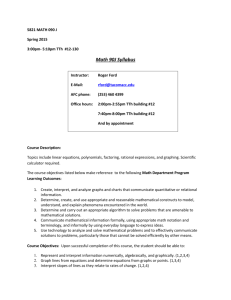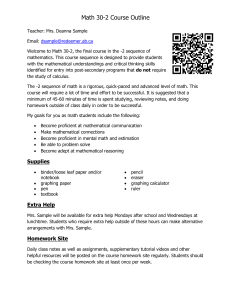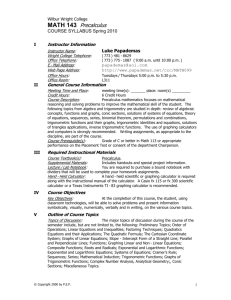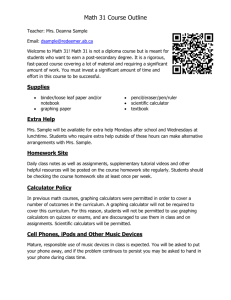Math 142 A 6060 Precalculus II
advertisement
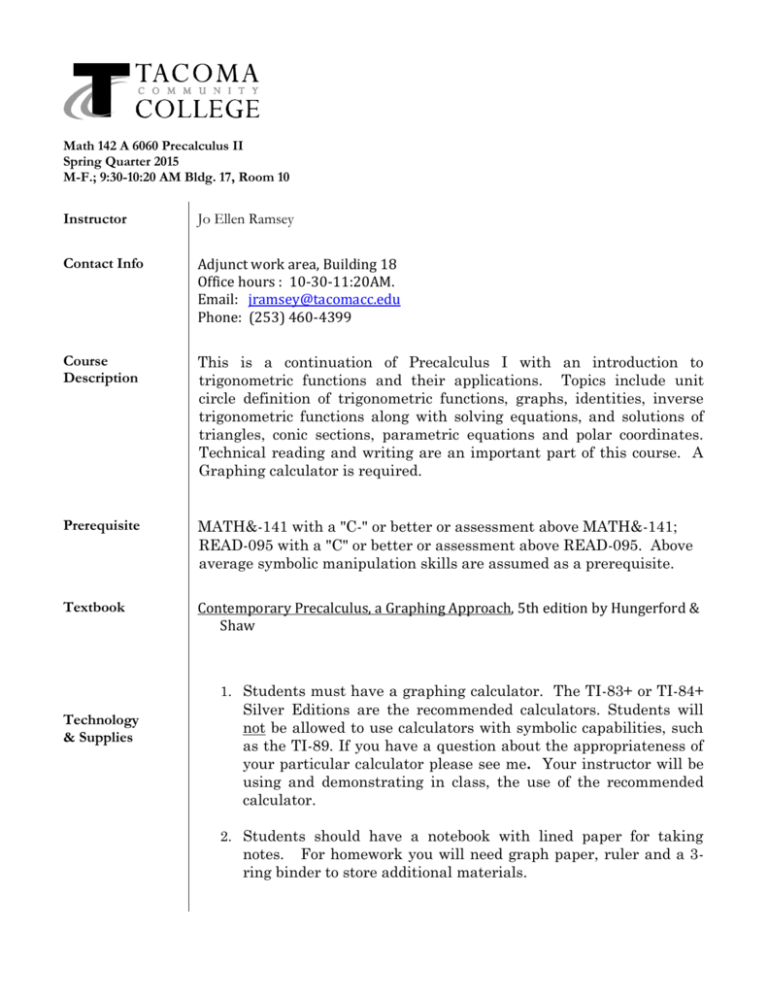
Math 142 A 6060 Precalculus II Spring Quarter 2015 M-F.; 9:30-10:20 AM Bldg. 17, Room 10 Instructor Jo Ellen Ramsey Contact Info Adjunct work area, Building 18 Office hours : 10-30-11:20AM. Email: jramsey@tacomacc.edu Phone: (253) 460-4399 Course Description This is a continuation of Precalculus I with an introduction to trigonometric functions and their applications. Topics include unit circle definition of trigonometric functions, graphs, identities, inverse trigonometric functions along with solving equations, and solutions of triangles, conic sections, parametric equations and polar coordinates. Technical reading and writing are an important part of this course. A Graphing calculator is required. Prerequisite MATH&-141 with a "C-" or better or assessment above MATH&-141; READ-095 with a "C" or better or assessment above READ-095. Above average symbolic manipulation skills are assumed as a prerequisite. Textbook Contemporary Precalculus, a Graphing Approach, 5th edition by Hungerford & Shaw 1. Students must have a graphing calculator. The TI-83+ or TI-84+ Technology & Supplies Silver Editions are the recommended calculators. Students will not be allowed to use calculators with symbolic capabilities, such as the TI-89. If you have a question about the appropriateness of your particular calculator please see me. Your instructor will be using and demonstrating in class, the use of the recommended calculator. 2. Students should have a notebook with lined paper for taking notes. For homework you will need graph paper, ruler and a 3ring binder to store additional materials. Evaluation Criteria Warning: This is a challenging course. You should expect to spend three (3) hours a night on assignments. Quality of work: In general, “answers” to mathematical problems are not more important than the reasoning leading up to those answers and the conclusions drawn from them. Thus, although a certain component of your grade on work in this class is performing calculations and mathematical procedures correctly, equally important components are well-organized work that leads to the answer and clearly written explanations of reasoning and conclusions. For this reason, in all written work (problem sets, quizzes, exams etc.) an answer without the work leading to it will receive little or no credit. A significant component of grading of all work will be on the organization and clarity of your written explanations and reasoning. Success in this course will depend on several of the following criteria. 1) Attendance is absolutely necessary as a minimum level of participation. You are expected to be on time and remain in class for the entire time period. You will be given points for each class period. If you are late for class or leave early, points may be deducted from this category. 2) Homework: There will be two kinds of homework for this class: WebAssign is an online homework system. You enroll yourself in the class by following the instructions below. a) On a computer, go to www.webassign.net b) Click I have a class key. c) Enter this class key tacomacc 6596 3792 and click Submit. d) If the correct class and section are listed, click Yes, this is my class. e) Select either I already have a WebAssign account or I need to create a WebAssign account. f) Enter the requested information. *It is important to remember your Username, Password and Institution Code (tacomacc). You will always go to www.webassign.net to login. On the WebAssign homepage, you will find the support resources you need under the “Student Support” Written homework will be collected in class before the beginning of class, on the date it is due. Written homework must meet the following criteria in order to be accepted: a) Stapled, neat and orderly, using a vertical format for algebraic steps. b) In pencil, not ink please. (Use your eraser. No cross-outs) c) On 8.5” x 11” lined or graph paper. (not torn-out with ragged edges.) d) Problems should be copied (including instructions). e) Show all work explaining steps where necessary. Strive for complete explanations using sentences. “Yes”, or “No” or “See graph” are not acceptable. f) All graphs should adhere to the provided Graphing Guidelines (attached to this syllabus). Math 142 Ramsey 3 g) Store bought graph or engineering paper with at least 0.25” squares. h) The work for graphs should be presented beside the graph, not on a separate page. i) Fractions and rational expressions must be written vertically, like this: 54 or 31 9 - x2 x+3 3) Quizzes from the homework will occur frequently. These will consist of specific problems (see assignment page) involving writing, graphing, etc. To earn the points for these quizzes, the criteria (listed above) must be followed completely. 4) Tests: There will be three exams. Exams may not be made up. They will include multiple choice, short answer and essay problems. All tests will require the use of a graphing calculator. 5) Final Exam. There is a comprehensive final exam for this course. The Final exam will be given in class according to the finals schedule in the college class schedule. Grading Your grade in this course will be determined in the following manner: attendance (10%), homework/quizzes (25%), Tests (50%), Final exam (15%). The final grades will be based on the following percentage scale: 92-100 % 90-91% 88-89% 82-87% 80-81% =A = A= B+ =B = B- 78-79% 74-77% 70-73% 60-69% 0-59% = C+ =C = C=D =F An incomplete will be given only in cases of emergency at instructor’s discretion. Academic Dishonesty As stated in the TCC catalog, ‘Students are expected to be honest and forthright in their academic endeavors. Cheating, plagiarism, fabrication or other forms of academic dishonesty corrupt the learning process and threaten the educational environment for all students.’ The complete Administrative Process for Academic Dishonesty is available on the TCC website at: www.tacomacommunitycollege.com/stuonline/policies/start.htm In this course sanctions for academic dishonesty will be as follows: A zero will be given for the first occurrence. A second occurrence will earn an F for the course. This is at the instructor’s discretion. Reading: Students should be developing the skill of reading a math textbook. The instructor is not obligated to lecture on every topic assigned. Reading a textbook is not the same as finding an example that matches the homework problem. Students should read actively with a pencil in hand. Math 142 Ramsey Accommodations Classroom Policies 4 Students with Special Needs. All students are responsible for all requirements of the class, but the way they meet these requirements may vary. If you need specific auxiliary aids or services due to a disability, please contact the Access Services office. They will require you to present formal, written documentation of your disability from an appropriate professional. When this step has been completed, arrangements will be made for you to receive reasonable auxiliary aids or services. The disability accommodation documentation prepared by Access Services must be given to me before the accommodation is needed so that appropriate arrangements can be made . You are expected to be in class everyday, on time. Homework is assigned everyday. It should be completed by the next day of class. The instructor may ask to view your homework during class. You can expect to work on homework outside of class for two to three hours each day. Cell phones should be turned off during class. Sharpen pencils, throw away garbage, or use the restroom before class. When class starts you should be ready to work for the entire time. Classroom Concerns Disputes If you have questions or concerns about this class, please come to talk with me about your concerns. If we are unable to resolve your concerns, you may talk next with the Chair of the Department; The Chair can assist with information about additional steps, if needed. Caveats This syllabus and schedule are subject to change in the event of extenuating circumstances. If you are absent from class, it is your responsibility to check on announcements made and/or handouts given out while you were absent. Occasionally your TCC e-mail address may be used to communicate with you. You are responsible for checking regularly. Math Department Program Learning Outcomes 1. Create, interpret, and analyze graphs and charts that communicate quantitative or relational information. 2. Determine, create and use appropriate and reasonable mathematical constructs to model, understand, and explain phenomena encountered in the world. 3. Determine and carry out an appropriate algorithm to solve problems that are amenable to mathematical solutions. 4. Communicate mathematical information formally, using appropriate math notation and terminology, and informally by using everyday language to express ideas. 5. Use technology to analyze and solve mathematical problems and to effectively communicate solutions to problems, particularly those that cannot be solved efficiently by other means. Math 142 Ramsey Course Learning Objectives 5 Upon successful completion of this course, the student should be able to: 1. Demonstrate an understanding of the unit circle definition of sine, cosine and tangent. (2, 4) 2. Create and analyze the graphs of trigonometric functions. (1, 2) 3. Use the unit circle, point in the plane, and right triangle descriptions to evaluate trigonometric functions and solve problems. (2, 4) 4. Use trigonometric functions to model numeric relationships expressed graphically, verbally, or in tables of values. (2, 3, 4) 5. Use trigonometric identities to simplify an expression or solve an equation. (3, 4) 6. Demonstrate an understanding of the inverse trigonometric functions. (2,4) 7. Solve trigonometric equations both graphically and analytically. (3, 4, 5) 8. Determine the standard equations of ellipses, hyperbolas and parabolas and use the equations to graph conic sections. (1, 3, 4) 9. Use the geometric properties of the conic sections in applications. (2, 3, 4) 10. Apply parametric equations and graph the associated plane curve. (1) 11. Write clear and complete solutions to mathematical problems, including correct notation and written explanations when appropriate. (4) 12. Use graphing calculator and/or computer software as appropriate. (5) Math 142 Ramsey TCC Mathematics Department 6 Student Graphing Guidelines Students in all math classes are expected to follow the graphing guidelines below on homework and test questions requiring an accurate sketch. AXES: Axes and any straight lines are drawn in with a straight edge. If the scale is anything other than one square = one unit, it must be clearly indicated on each axis. For word problems, each axis is labeled with an appropriate letter and with the meaning and units of the axis. (See Graph B.) ACCURATE: Graph paper is used. Instructors will set a clear convention for distinguishing a graph that terminates from one that extends infinitely. Students will adhere to the convention set by their instructor. CLEAR: The coordinates of important points: intercepts, maximum or minimum points, vertices, and points of intersection, are clearly labeled on the axes or the point itself is labeled with an ordered pair. If multiple equations are graphed on a single set of axes, each graph should be labeled with its equation. Separate problems should be graphed on separate axes. The size of the graph is helpful: it is neat, big, and dark enough to be easily read and understood.


